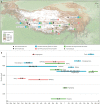Paleoproteomic evidence reveals dairying supported prehistoric occupation of the highland Tibetan Plateau
- PMID: 37043579
- PMCID: PMC10096579
- DOI: 10.1126/sciadv.adf0345
Paleoproteomic evidence reveals dairying supported prehistoric occupation of the highland Tibetan Plateau
Abstract
The extreme environments of the Tibetan Plateau offer considerable challenges to human survival, demanding novel adaptations. While the role of biological and agricultural adaptations in enabling early human colonization of the plateau has been widely discussed, the contribution of pastoralism is less well understood, especially the dairy pastoralism that has historically been central to Tibetan diets. Here, we analyze ancient proteins from the dental calculus (n = 40) of all human individuals with sufficient calculus preservation from the interior plateau. Our paleoproteomic results demonstrate that dairy pastoralism began on the highland plateau by ~3500 years ago. Patterns of milk protein recovery point to the importance of dairy for individuals who lived in agriculturally poor regions above 3700 m above sea level. Our study suggests that dairy was a critical cultural adaptation that supported expansion of early pastoralists into the region's vast, non-arable highlands, opening the Tibetan Plateau up to widespread, permanent human occupation.
Figures




References
-
- J. Qiu, China: The third pole. Nature 454, 393–396 (2008). - PubMed
-
- Institute of Medicine, Nutritional Needs in Cold and High-Altitude Environments: Applications for Military Personnel in Field Operations (The National Academy Press, 1996). - PubMed
-
- X. Yi, Y. Liang, E. Huerta-Sanchez, X. Jin, Z. X. P. Cuo, J. E. Pool, N. Xu, H. Jiang, N. Vinckenbosch, T. S. Korneliussen, H. C. Zheng, T. Liu, W. M. He, K. Li, R. B. Luo, X. F. Nie, H. L. Wu, M. R. Zhao, H. Z. Cao, J. Zou, Y. Shan, S. Z. Li, Q. Yang, P. X. N. Asan, G. Tian, J. M. Xu, X. Liu, T. Jiang, R. H. Wu, G. Y. Zhou, M. F. Tang, J. J. Qin, T. Wang, S. J. Feng, G. H. Li, Huasang, J. Luosang, W. Wang, F. Chen, Y. D. Wang, X. G. Zheng, Z. Li, Z. Bianba, G. Yang, X. P. Wang, S. H. Tang, G. Y. Gao, Y. Chen, Z. Luo, L. Gusang, Z. Cao, Q. H. Zhang, W. H. Ouyang, X. L. Ren, H. Q. Liang, H. S. Zheng, Y. B. Huang, J. X. Li, L. Bolund, K. Kristiansen, Y. R. Li, Y. Zhang, X. Q. Zhang, R. Q. Li, S. G. Li, H. M. Yang, R. Nielsen, J. Wang, J. Wang, Sequencing of 50 human exomes reveals adaptation to high altitude. Science 329, 75–78 (2010). - PMC - PubMed
-
- J. Yang, Z.-B. Jin, J. Chen, X.-F. Huang, X.-M. Li, Y.-B. Liang, J.-Y. Mao, X. Chen, Z. Zheng, A. Bakshi, D.-D. Zheng, M.-Q. Zheng, N. R. Wray, P. M. Visscher, F. Lu, J. Qu, Genetic signatures of high-altitude adaptation in Tibetans. Proc. Natl. Acad. Sci. U.S.A. 114, 4189–4194 (2017). - PMC - PubMed
MeSH terms
LinkOut - more resources
Full Text Sources

